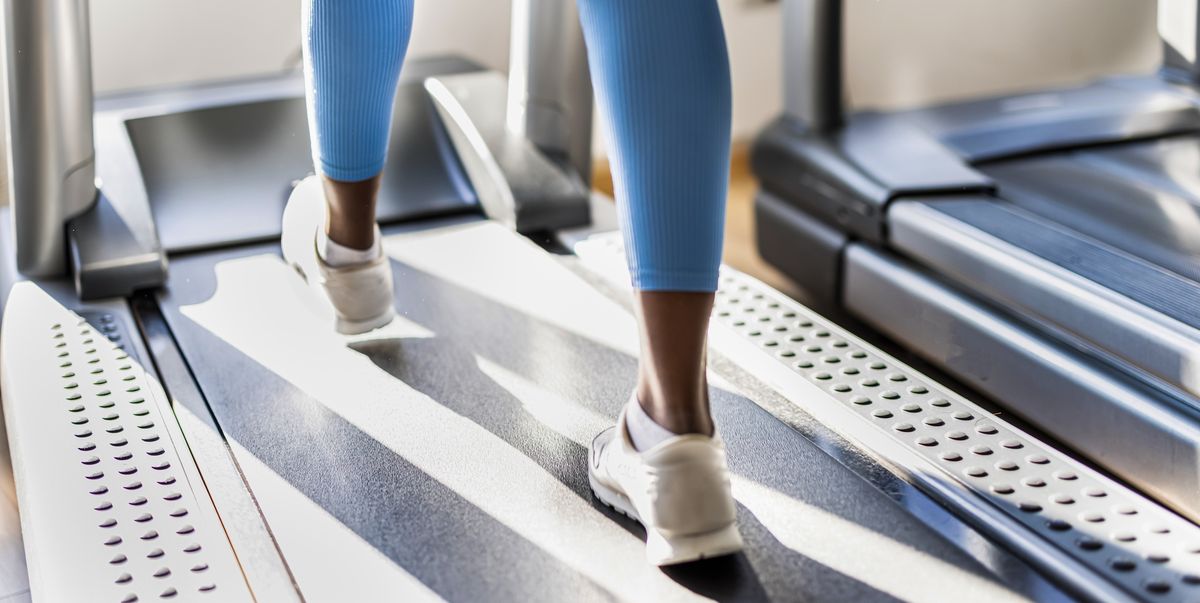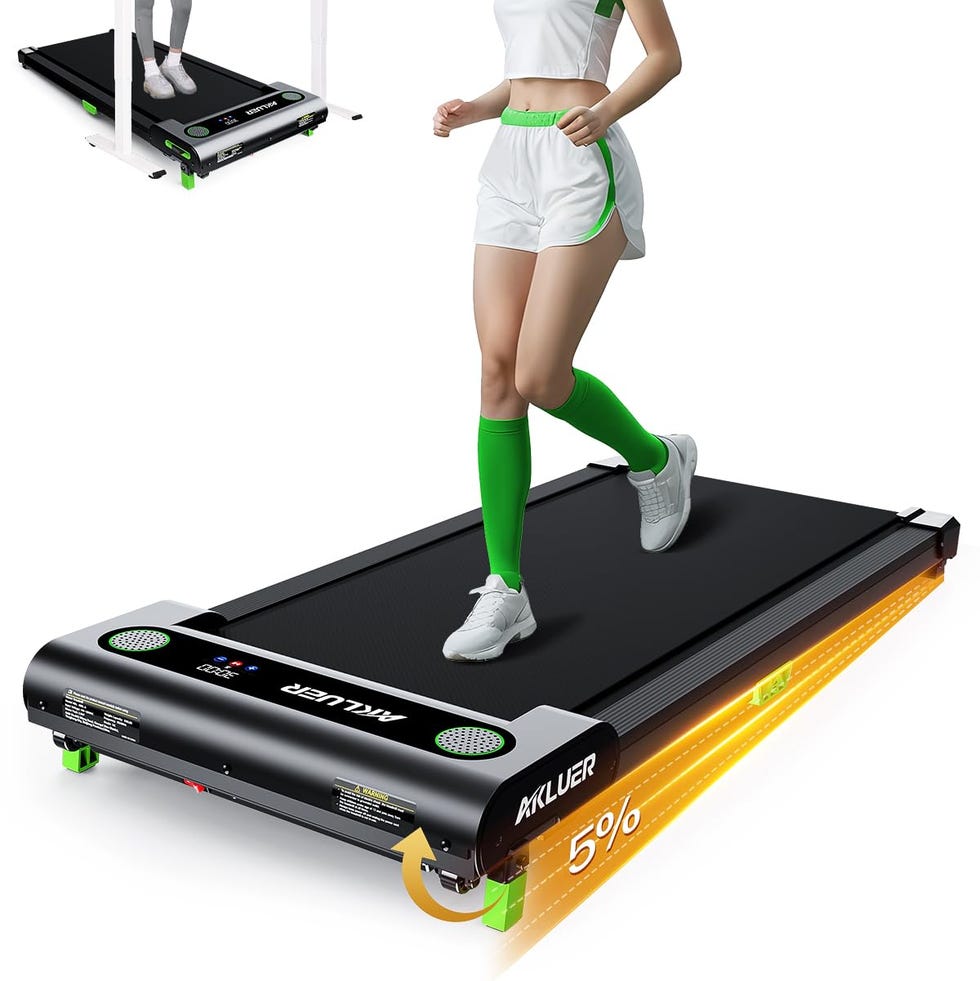Picture this: It’s frigid outside, and your motivation to lace up your sneakers is as low as the thermostat on this winter morning. Well, this indoor walking workout is about to warm up your body (and attitude).
The treadmill session is low-impact, beginner-friendly, and perfect for all fitness levels. It’s especially great for women over 50 looking for a gentle way to stay active without putting unnecessary stress on their joints. And if you’re a runner looking to mimic the motion of running without the impact, walking workouts fit the bill. “It’s a great form of training for somebody who’s maybe a runner and wants to move the body in a similar way, but without the impact,” says Corky Corkum, CPT, a Precision Run coach at Equinox and owner of Coach Corky Runs.
Walking on a treadmill is also an ideal primary aerobic workout for any exerciser who can safely use the cardio machine, says Corkum. “I think most people walk up to a treadmill and are like, ‘I don’t know what to do with this thing. How do I make a tread workout effective or not boring?’,” she says. But by walking on an incline—almost like hiking—you can turn a simple stroll into an incredibly efficient and impactful workout.
Not only can indoor walking workouts boost your heart rate, torch calories, and build endurance, but they’re also accessible year-round, rain or shine. “It can be an incredibly impactful workout as long as we’re leaning into the intensity—it’s all about the elevation.” Ready to take the first step (literally)? Let’s get moving.
Meet the expert: Corky Corkum, CPT, is a Precision Run coach at Equinox and owner of Coach Corky Runs.
Try This 30-Minute Indoor Walking Workout To Maximize Your Burn
This walking sequence is designed to get your heart pumping while keeping things low-impact and scalable. Adjust the speed and incline based on your fitness level, and feel free to tweak the workout to suit your needs (stay tuned for Corkum’s tips on how to do that right after the workout).
Warm-Up (5 minutes)
Walk at a slow, comfortable pace on a flat surface or a 3 to 5 percent incline. Focus on steady breathing and getting into the rhythm of your movement.
- During the warm-up, perform 1 minute of shoulder rolls to loosen up your upper body. “If you’re going up to a 12 or 15 percent incline, you want to prep your body for that range of motion,” says Corkum. “To warm up the upper body, things like shoulder stretches, reaching up towards the ceiling, and opening up the ribs are great to help you maintain good posture.”
- Do 1 minute of exaggerated high-knee marches with flexed ankles to activate your ankles, knees, and hips. “During the warm-up, I love doing things like high knee marches, really over exaggerating the movements and pulling those knees and toes up to the ceiling to warm up the ankles,” she says.
Incline Intervals (21 Minutes)
- 2 minutes: Walk at a moderate pace on a double-digit incline (10 percent or higher).
- 1 minute: Decrease the incline to 3 to 5 percent and maintain a steady pace.
- Repeat this interval 6 more times.
Cooldown (5 Minutes)
Indoor walking can be a really intense workout, so it’s important to bring everything back down progressively, just like you do with most intense workouts. “It’s very possible that if you’re pushing yourself really hard on a big incline, your heart rate’s going to be really high, breathing is going to be labored, and muscles are going to be burning,” says Corkum.
- 1 minute: Slow down your pace slightly while walking on a 3 to 5 percent incline.
- 2 minutes: Gradually lower the incline to flat, walking at a leisurely pace.
- 2 minutes: Continue to slow down, walking on a flat incline.
“If somebody’s really new to this, be mindful that the amount of soreness they might feel after this workout might be surprising, because it’s very different than just walking on a flat surface or outside,” says Corkum. “Even if you walk a lot, this workout is going to be working different muscle groups and your aerobic system in a more intense way than walking outdoors.”
The Best Indoor Walking Equipment
Whether you have a dedicated home gym space or a section of your living room cornered off for fitness, we’ve tested and approved some of the best treadmills and walking pads out there for every home and budget.
Tips To Make This Indoor Walking Workout Work For You
1. Lean in and don’t clutch the handles for dear life.
When walking on an incline, avoid holding onto the treadmill handles and leaning back—it reduces the effectiveness of your workout and increases injury risk, says Corkum. Instead, lean into the incline, just as you would while hiking outdoors. This engages your glutes, hamstrings, and core muscles, giving you a more efficient workout and minimizing strain on your back, hips, and knees, she says.
2. Slow down to focus on form and safety.
If you feel the need to hold on for balance or your form starts to break down, that’s a sign to slow down, says Corkum. “Walking with good posture, even at a snail’s pace, is far more effective—and safer—than holding onto the machine at a faster speed.” Low impact should mean low injury risk, so prioritize control and form over speed.
3. Play with speed and incline to find your sweet spot.
Experiment with different combinations of speed and incline to discover what works best for your body. “A higher incline at a slower pace is often ideal for maximizing strength and fitness gains without causing discomfort or injury,” she says. If something feels off, don’t hesitate to adjust the settings.
4. Kick boredom by playing around with the intervals.
Tread workouts can get boring, so keep things engaging by incorporating (and adjusting) intervals. For example, if your 2-minute interval at double digit incline starts to feel easy, push it to three minutes—or shorten the 1-minute interval at 3 to 5 percent incline to just 30 seconds. Instead of sticking to rigid settings, play with elevation and pace to match your fitness level and goals. This approach not only challenges your muscles and aerobic system but also keeps boredom at bay.
5. Respect the challenge and start small.
Indoor walking workouts, especially on high inclines, can be surprisingly challenging. “If you’re new to this, start with shorter durations or lower inclines and gradually build up your endurance,” says Corkum. “It’s normal to feel humbled—trust the process, and your strength will grow over time.” No matter where you start, indoor walking is a fantastic way to prioritize your health without overcomplicating things. Lace up, tune into your favorite playlist or podcast, and let those steps add up to something great.
Talene Appleton is the fitness editor at Women’s Health, where she covers all things fitness, nutrition, and healthy living. She studied nutrition and exercise science at George Washington University and is a NASM-certified personal trainer and nutritional consultant. Passionate about the intersections between fitness, food, and community, she strives to foster inclusive and holistic wellness narratives for underrepresented populations. When not writing, she can be found hosting dinner parties and exploring new wellness and culinary experiences around New York and Los Angeles. Prior to her role at Women’s Health, she was the fitness and commerce editor at Men’s Health and contributed to General Surgery News, The Food Institute, and The Nessie.
Read the full article here








